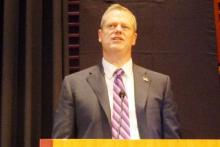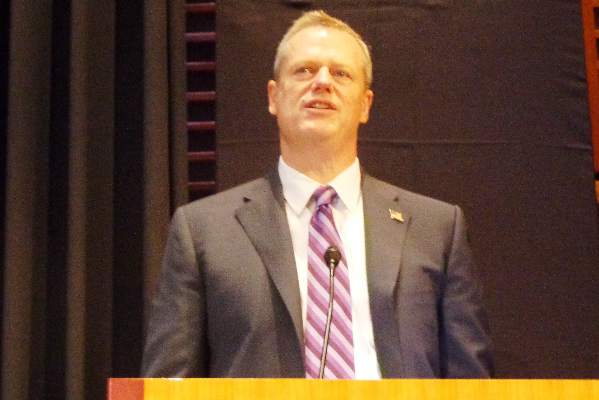User login
ICOO: Massachusetts governor takes on opioid epidemic
BOSTON – A campaign promise to create viable strategies aimed at reducing the overuse of prescription opioids will be fulfilled, the governor of Massachusetts said during a keynote address at the International Conference on Opioids.
Without providing many specifics, Gov. Charles D. Baker (R) reported that the task force he created will soon release recommendations around three major components: 1. prevention and education; 2. addiction and intervention; and 3. the treatment of pain. He emphasized the importance of a comprehensive strategy.
“I am smart enough to know or humble enough to know that any one initiative in regard to this type of thing is unlikely to get us to where we need to go,” Gov. Baker said. Decriminalizing addiction will be part of the strategy aimed at reducing roadblocks to treatment, he said.
The opioid epidemic was not an initial part of Gov. Baker’s 2014 platform in his campaign for governor. Rather, he added a promise to address this problem in his inaugural address after voters expressed their concern repeatedly. He reported being “astonished” by how often he heard stories of addiction to prescription opioids.
“It didn’t matter where I was. It didn’t matter what part of the commonwealth I was in. It did not matter what kind of neighborhood I was in. It didn’t matter what the socioeconomic demographic makeup was of the group I was talking to,” Gov. Baker said. “It was literally everywhere.”
He said hard numbers tell the same story. In addition to the often repeated national statistics regarding the rapid increase in opioid prescriptions and its close correlation with opioid-related deaths, he said no area of Massachusetts has been left untouched. According to Gov. Baker, the largest hospital in the town of Plymouth, Mass., which has a population just under 60,000, is now averaging one opioid overdose per day.
“I am one of those people who thinks that you cannot solve this problem if you do not engage the health care community,” Gov. Baker said. One reason to focus on health care providers, the governor said, is that data from the Substance Abuse and Mental Health Services Administration show that a large percentage of patients addicted to heroin started on prescription pain medication.
The thrust of the coming initiatives is therefore likely to advocate pain medicine practice that reduces inappropriate prescriptions, Gov. Baker said. He noted that an initiative started 2 years ago by Blue Cross Blue Shield of Massachusetts resulted in a 25% reduction in opioid prescribing without restricting pain medications for those who need them.
In general, the address, which was heavily covered by the local news media, was well-received by those who attended the International Conference on Opioids. There was one area of disagreement. Many did not believe that most heroin addictions start with a prescription pain medication. Of those who challenged that assertion, Dr. Carol A. Warfield, the Lowenstein Distinguished Professor of Anesthesia at Harvard Medical School, Boston, clarified that those opioids might have been prescription drugs but were not prescribed to the user. Rather, the drugs were diverted, and this is a much more important focus of efforts to halt the epidemic than new restrictions on their use for pain control.
Similarly, Pamela J. Madej, a registered nurse affiliated with the Albany Center for Pain Management, New York, cautioned against overemphasizing the value of regulating opioids. She said plenty of regulations exist in New York but the problem persists. Many people are self-medicating for mental health disorders, she said, including the chronic brain disorder of addiction, for which coverage continues to be limited.
“Patients switch from hydrocodone to heroin, because heroin is cheaper,” Ms. Madej said. “We need expanded coverage for mental health to address the underlying problem.”
BOSTON – A campaign promise to create viable strategies aimed at reducing the overuse of prescription opioids will be fulfilled, the governor of Massachusetts said during a keynote address at the International Conference on Opioids.
Without providing many specifics, Gov. Charles D. Baker (R) reported that the task force he created will soon release recommendations around three major components: 1. prevention and education; 2. addiction and intervention; and 3. the treatment of pain. He emphasized the importance of a comprehensive strategy.
“I am smart enough to know or humble enough to know that any one initiative in regard to this type of thing is unlikely to get us to where we need to go,” Gov. Baker said. Decriminalizing addiction will be part of the strategy aimed at reducing roadblocks to treatment, he said.
The opioid epidemic was not an initial part of Gov. Baker’s 2014 platform in his campaign for governor. Rather, he added a promise to address this problem in his inaugural address after voters expressed their concern repeatedly. He reported being “astonished” by how often he heard stories of addiction to prescription opioids.
“It didn’t matter where I was. It didn’t matter what part of the commonwealth I was in. It did not matter what kind of neighborhood I was in. It didn’t matter what the socioeconomic demographic makeup was of the group I was talking to,” Gov. Baker said. “It was literally everywhere.”
He said hard numbers tell the same story. In addition to the often repeated national statistics regarding the rapid increase in opioid prescriptions and its close correlation with opioid-related deaths, he said no area of Massachusetts has been left untouched. According to Gov. Baker, the largest hospital in the town of Plymouth, Mass., which has a population just under 60,000, is now averaging one opioid overdose per day.
“I am one of those people who thinks that you cannot solve this problem if you do not engage the health care community,” Gov. Baker said. One reason to focus on health care providers, the governor said, is that data from the Substance Abuse and Mental Health Services Administration show that a large percentage of patients addicted to heroin started on prescription pain medication.
The thrust of the coming initiatives is therefore likely to advocate pain medicine practice that reduces inappropriate prescriptions, Gov. Baker said. He noted that an initiative started 2 years ago by Blue Cross Blue Shield of Massachusetts resulted in a 25% reduction in opioid prescribing without restricting pain medications for those who need them.
In general, the address, which was heavily covered by the local news media, was well-received by those who attended the International Conference on Opioids. There was one area of disagreement. Many did not believe that most heroin addictions start with a prescription pain medication. Of those who challenged that assertion, Dr. Carol A. Warfield, the Lowenstein Distinguished Professor of Anesthesia at Harvard Medical School, Boston, clarified that those opioids might have been prescription drugs but were not prescribed to the user. Rather, the drugs were diverted, and this is a much more important focus of efforts to halt the epidemic than new restrictions on their use for pain control.
Similarly, Pamela J. Madej, a registered nurse affiliated with the Albany Center for Pain Management, New York, cautioned against overemphasizing the value of regulating opioids. She said plenty of regulations exist in New York but the problem persists. Many people are self-medicating for mental health disorders, she said, including the chronic brain disorder of addiction, for which coverage continues to be limited.
“Patients switch from hydrocodone to heroin, because heroin is cheaper,” Ms. Madej said. “We need expanded coverage for mental health to address the underlying problem.”
BOSTON – A campaign promise to create viable strategies aimed at reducing the overuse of prescription opioids will be fulfilled, the governor of Massachusetts said during a keynote address at the International Conference on Opioids.
Without providing many specifics, Gov. Charles D. Baker (R) reported that the task force he created will soon release recommendations around three major components: 1. prevention and education; 2. addiction and intervention; and 3. the treatment of pain. He emphasized the importance of a comprehensive strategy.
“I am smart enough to know or humble enough to know that any one initiative in regard to this type of thing is unlikely to get us to where we need to go,” Gov. Baker said. Decriminalizing addiction will be part of the strategy aimed at reducing roadblocks to treatment, he said.
The opioid epidemic was not an initial part of Gov. Baker’s 2014 platform in his campaign for governor. Rather, he added a promise to address this problem in his inaugural address after voters expressed their concern repeatedly. He reported being “astonished” by how often he heard stories of addiction to prescription opioids.
“It didn’t matter where I was. It didn’t matter what part of the commonwealth I was in. It did not matter what kind of neighborhood I was in. It didn’t matter what the socioeconomic demographic makeup was of the group I was talking to,” Gov. Baker said. “It was literally everywhere.”
He said hard numbers tell the same story. In addition to the often repeated national statistics regarding the rapid increase in opioid prescriptions and its close correlation with opioid-related deaths, he said no area of Massachusetts has been left untouched. According to Gov. Baker, the largest hospital in the town of Plymouth, Mass., which has a population just under 60,000, is now averaging one opioid overdose per day.
“I am one of those people who thinks that you cannot solve this problem if you do not engage the health care community,” Gov. Baker said. One reason to focus on health care providers, the governor said, is that data from the Substance Abuse and Mental Health Services Administration show that a large percentage of patients addicted to heroin started on prescription pain medication.
The thrust of the coming initiatives is therefore likely to advocate pain medicine practice that reduces inappropriate prescriptions, Gov. Baker said. He noted that an initiative started 2 years ago by Blue Cross Blue Shield of Massachusetts resulted in a 25% reduction in opioid prescribing without restricting pain medications for those who need them.
In general, the address, which was heavily covered by the local news media, was well-received by those who attended the International Conference on Opioids. There was one area of disagreement. Many did not believe that most heroin addictions start with a prescription pain medication. Of those who challenged that assertion, Dr. Carol A. Warfield, the Lowenstein Distinguished Professor of Anesthesia at Harvard Medical School, Boston, clarified that those opioids might have been prescription drugs but were not prescribed to the user. Rather, the drugs were diverted, and this is a much more important focus of efforts to halt the epidemic than new restrictions on their use for pain control.
Similarly, Pamela J. Madej, a registered nurse affiliated with the Albany Center for Pain Management, New York, cautioned against overemphasizing the value of regulating opioids. She said plenty of regulations exist in New York but the problem persists. Many people are self-medicating for mental health disorders, she said, including the chronic brain disorder of addiction, for which coverage continues to be limited.
“Patients switch from hydrocodone to heroin, because heroin is cheaper,” Ms. Madej said. “We need expanded coverage for mental health to address the underlying problem.”

